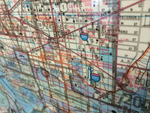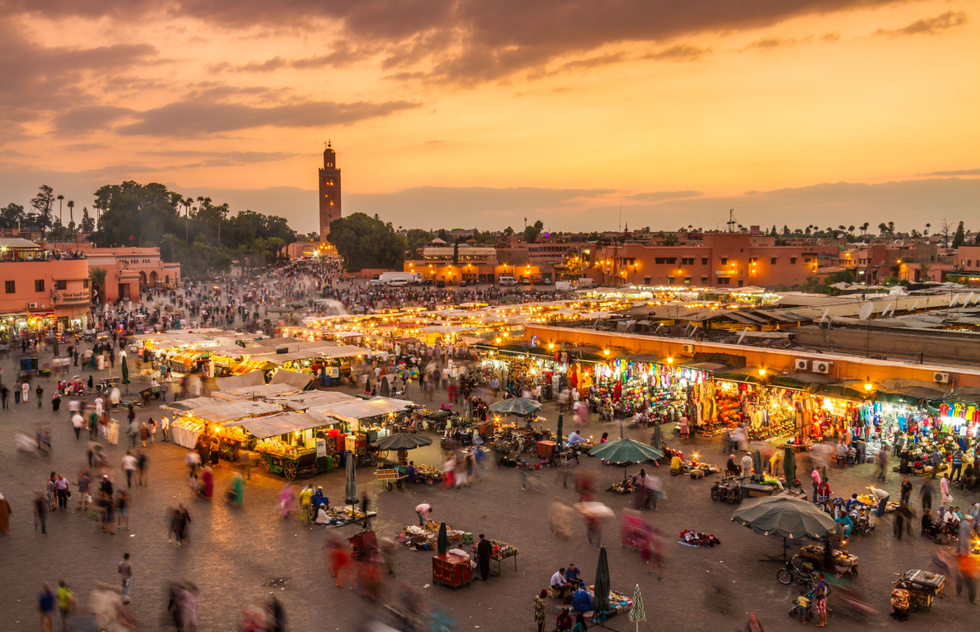When I got an invitation from the Moroccan National Tourist Office to travel and observe the Marrakech International Storytelling Festival, I leapt at the chance. For over twenty years, I’ve been telling stories as an arts journalist for NPR and other outlets, and for even longer, I’ve been a theater composer, writing musicals and incidental music for plays. So the chance to meet and hear artists from around the world express their folkloric tales in one of the oldest centers of storytelling, the thousand-year-old city of Marrakech, was irresistible.
The main festival venue was a large tent erected on Jemaa el Fna, the large central gathering space of Marrakech located in the heart of the medina [ancient walled section]. It’s not quite a square—its shape is more like a bowtie, and it changes over the course of the day from sleepy to loud as vendors set up stalls.
I started out as a tourist, arriving at Jemaa el Fna early in the morning and getting my picture taken with some of the snake charmers there.
One of the charmers was playing the ghaita, a kind of oboe, and yes, indeed, there were cobras, right out in the open. For a somewhat hefty tip, the charmer put a couple of harmless snakes around my neck and took photos of me standing behind the deadly cobras. I felt hustled, but it’s not like taking a picture with Elmo in Times Square—these were not like Disney characters.
I’m a fairly experienced traveler, but this was my first trip to a primarily Islamic country and I was a tad nervous, as I speak neither Arabic nor French, which is also spoken in Morocco as a relic of its colonial past.
But after a few days of playing follow the leader as a tourist with fellow festival attendees, I decided to take an entire day to explore Marrakech on my own and get lost in the medina.
More than meets the eye
The first thing I discovered about Marrakech is the medina is a confusing—and ultimately delightful—series of twisting and turning alleyways. Visitors walk past stalls that sell spices, slippers, carpets, and other goods, all while trying to avoid motorcycles or donkey carts and their inevitable droppings or stepping on cats—the streets of Marrakech are filled with those. And not coincidentally, you won’t see a rat anywhere.
I’ve got a pair of cats at home, and over the course of my trip I befriended many of the felines I saw, and I posted a series of photos on Instagram, with the hashtag #catsofmarrakech. (Yes, there is such a hashtag.)

There is a Moroccan tradition of “blind architecture,” in which a doorway or arch may appear unobtrusive, but when you enter it, an entire world opens up. Many of the storytelling events were held in riads, which are former private homes that usually have an elaborately tiled open central courtyard featuring gardens, orange trees, or fountains. Many of these riads are now hotels, restaurants, or museums.
I next went to the balcony of one of the many outdoor cafes surrounding Jemaa el Fna to watch the square come to life. I ordered what the locals call "Berber whiskey": highly sweetened mint tea, poured from about a foot above the glass—never into a teacup or mug. The term Berber, by the way, was once an insult—a reference to the original people of this part of Morocco, the Amazighs, as barbarians. But everywhere I went, at the end of the meal, I was offered Berber whiskey, in an Islamic country where few people drink alcohol. It’s a point of pride.
Once I had drunk the tea, I went off into the souks with no defined agenda. I just wanted to see where my feet took me. I’m a musician, so whenever I visit a new country, I like to learn about the local scene. I happened upon a small shop filled with drums and stringed instruments. Mohammed Fiad, the owner (pictured below), was standing over a workbench with scraps of wood, string, and ceramics—the things he uses to make his instruments.
While he barely spoke English, we ended up having meaningful communication. He showed me how he makes a gimbri (a three-stringed lute with a long neck) out of dry, hollowed-out gourds and wood. And he taught me how to play a ceramic drum called a tareja. I bought a lovely small one for the equivalent of US $5. He was able to make it sing, but I’m going to need a little more practice.

My new drum in my backpack, I continued wandering. If one is willing to engage in the blind architecture and walk through doorways, there are myriad delights. Among them is the Musée de Marrakech, a history museum in a spectacular riad, chock full of artifacts and contemporary art.
Another discovery was the Secret Garden—a recent project built on the site of a riad in the center of the medina, with a traditional garden, gazebo, and fountains. And it’s a place of calm amidst the chaos.
There was one more thing I wanted to experience in the medina: authentic street food. I found a small stand with a few tables where a genial man named Omar talked me through the various foods displayed in steam dishes.
I selected some lamb tripe with chickpeas, deep-fried sardines, eggplant, and French fries, accompanied by Berber whiskey, all for considerably less than $10. After tasting it, I decided tripe is not my style, but everything else was delicious. And as I sampled the food, a tabby cat (who I later learned was named Moumou) sat at my feet, begging for scraps. He was generously rewarded.
I had a wonderful week, meeting lots of voluble, somewhat eccentric storytellers from around the world and hearing some entertaining myths and folklore. With the tour group, I visited the major tourist spots: the Koutoubia Mosque, with its enormous minaret and gardens; the elaborate Bahia Palace in the Mellah, the Jewish quarter; the Majorelle Gardens and Yves Saint Laurent Museum. We even took a short day trip to the Agafay Desert, just southwest of Marrakech, for a camel ride. And I had some spectacular meals.
But for sheer pleasure, I highly recommend getting lost in the medina of Marrakech and being surprised.
Jeff Lunden is a freelance arts reporter and public radio producer whose work is featured on NPR. He is also a theater composer whose adaptation of Arthur Kopit's Wings (with Arthur Perlman) played at New York's Public Theater and the Goodman Theater in Chicago.






